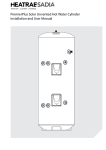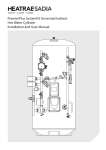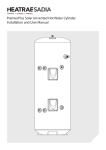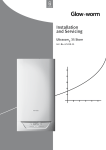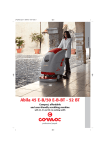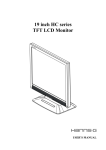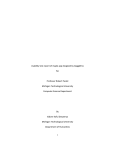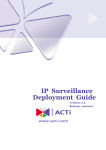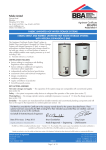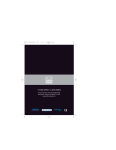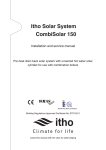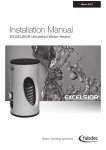Download Electric Water Heater User Manual - Enviro-tex
Transcript
Cod. 123000 – agg. 13/11/2014 Oversink and Undersink Electric Water Heater Installation and Service Instructions Oversink and Undersink Water Heater INTRODUCTION Cod. 176542 176543 176544 176545 Decription Style 10L 2kW Oversink Style 10L 2kW Undersink Style 15L 2kW Oversink Style 15L 2kW Undersink The following information incorporates both the installation and servicing instructions and should be left in a safe place adjacent to the water heater or given to the end user once the end user has been correctly instructed in the effective operation of the water heater. The Installer has a duty of care to instruct the end user how to operate the electric water heater correctly, failure to undertake this instruction will result in the cancellation of the warranty. These instructions include essential and important information for safe and correct installation, and are an integral part of the product. As a consequence all technical documents must always accompany the product. Giona UK is continually developing its product range and therefore reserve the right to change specification without prior notice. All the data and instructions contained in this manual are subject to review or product update changes at any time. They will be current at time of print. Please contact the manufacture to ensure you have the correct and current manual. Please always refer to the instructions contained in this manual when installing the equipment. The operations described in these instructions require specialized knowledge and therefore it is essential the installer has ascertained the appropriate qualifications and competence training prior to installing the product. You should only install this product once you have achieved such technical qualifications. The instructions are provided in schematic form only as installations designs may vary. The diagrams used are purely INDICATIVE, have no pretense of completeness and are not intended to replace the design. © 2013 Giona UK reserve the right to change this document at any time. All rights reserved. Giona UK Ltd cannot be held liable for any loss or damage arising from product specifications deviating from the standard version. The information contained within this document has been compiled with all possible care, Giona UK Ltd cannot be held liable for any installation errors, loss or damage or work performed by third parties. Subject to change THIS MANUAL IS TO BE LEFT WITH THE END USER - 2- Oversink and Undersink Water Heater TABLE OF CONTENTS 1 GENERAL NOTICE ........................................................... 4 1.1 1.2 1.3 1.4 1.5 1.6 1.7 1.8 1.9 2 Personal responsability ............................................ 4 Field of use ................................................................. 4 Requirement and safety normes ............................. 4 Certifications and markings ..................................... 4 Components identification ...................................... 5 Vessel ......................................................................... 6 Anode ......................................................................... 6 Meaning of the symbols used herein ...................... 6 Measuring .................................................................. 6 SAFETY ............................................................................ 6 2.1 2.2 2.3 2.4 2.5 3 Wall mounting ........................................................... 6 Electrical ..................................................................... 6 Unvented ................................................................... 6 Personal protection .................................................. 6 Delivery and packaging ............................................ 6 TECHNICAL DATA ........................................................... 7 3.1 3.2 3.3 4 Dimensions and water connection .......................... 7 Technical data table .................................................. 7 Pack contents ............................................................ 7 INSTALLATION................................................................ 8 4.1 4.2 4.3 4.4 4.5 4.5.1 4.6 Maintenance space requirements ........................... 8 Electrical connection ................................................. 8 Safety limiting device (manual reset)...................... 9 Safety relief valve ...................................................... 9 Water connections .................................................. 10 Building Regulation G3 ................................................... 10 Unit filling ................................................................ 13 4.7 4.8 5 5.1 5.2 5.3 6 6.1 6.2 6.3 6.4 6.5 6.6 6.7 7 Unit emptying ......................................................... 13 Long period without use ........................................ 13 USAGE INSTRUCTIONS ................................................ 13 Switch-on ................................................................ 13 Dripping from water safety unit. .......................... 13 Temperature adjustment....................................... 13 COMMISSIONING SYSTEM .......................................... 14 Electrical Check ....................................................... 14 Pre-Fill Check .......................................................... 14 Filling the water heater .......................................... 14 Drain water heater ................................................. 15 Cleaning the water heater ..................................... 15 Setting And Testing Controls ................................ 15 Handing Over .......................................................... 15 MAINTENANCE INSTRUCTIONS .................................. 15 7.1 General .................................................................... 15 7.2 Control/Replacement of anode ............................. 15 7.3 Temperature ........................................................... 16 7.4 Descaling and limestone deposit removal ........... 16 7.5 Replace and/or inspect the electric heating element .................................................................................. 16 7.6 Outside cleaning ..................................................... 16 7.7 Hydraulic safety unit efficiency check .................. 16 7.8 Simple checks should a malfunction occur .......... 16 7.9 General notes .......................................................... 17 7.10 Spare parts .............................................................. 18 7.11 After-sale service .................................................... 18 8 GUARANTEE TERMS AND CONDITIONS ..................... 19 - 3- Oversink and Undersink Water Heater 1 GENERAL NOTICE 1.1 Personal responsability The manufacturer is responsible for the product’s conformity to the relevant CE directives, laws and regulations in force at the time the product is first brought to market. The Installer is responsible to ensure the Installation Company and / or its operatives have been trained and hold the appropriate qualifications and are up to date with current regulations and legislation enforce at the time of installation. This includes compliance with the Water Supply (Water Fittings) Regulations 1999 in England and Wales, Water Byelaws 2000 Scotland, Water Bylaws currently enforce in Ireland. L8 for commercial buildings and NHS Guidance for all NHS premises. The design of the system, installation, operation and maintenance of the appliance is the Installer responsibility. Reference to laws, regulations or technical specifications contained in this manual is purely for information purposes. New laws introduced or modifications to existing laws are not in any way binding on the manufacturer towards third parties. This appliance can be used by children aged from 8 years and above and persons with reduced physical, sensory or mental capabilities or lack of experience and knowledge if they have been given supervision or instruction concerning use of the appliance in a safe way and understand the hazards involved. Children shall not play with the appliance. Cleaning and user maintenance shall not be made by children without supervision. The appliance is not intended to be connected to the water mains by the use of a hose set. 1.2 Field of use The electric water heater for the production of hot water is only intended to be used for Domestic Hot Water heating for residential or light commercial application, without exceeding the usage restrictions specified herein. To this purpose it must be hydraulically connected to a domestic hot water delivery network. It requires a power supply to operate. Never use the electric water heater for any purposes other than those specified herein. Any other use is to be deemed as inappropriate and is not allowed. The manufacturer cannot be held responsible for any installation errors and inappropriate equipment use. 1.3 Requirement and safety normes The Installer is responsible for the design and function of the installation. The Manufacturer will not be held responsible or liable for any damages caused by incorrect or poor installation and/or non-compliance with the instructions contained in these Installation, End User and Service Instructions, and in particular with those described in the following: It’s not allow to install the water heater outdoor; the electrical connection must comply with the provisions specified in the relevant paragraph; the supplied nylon electrical protectors must be properly installed; Installation and maintenance must be performed by qualified personnel, and in accordance with the current regulations and local by-law; the maintenance regulations must be observed; the equipment must be installed in an appropriate room (to avoid being exposed to frost); the maximum overpressure, when using the water heater, must be observed; the maximum temperature, when using the water heater, must be observed. CAUTION! FAILURE TO COMPLY WITH THE ABOVE INSTRUCTIONS WILL RESULT IN THE CANCELLATION OF YOUR WARRANTY. This equipment complies with the provisions contained in the EEC Directives in force. 1.4 Certifications and markings The CE marking applied to the appliance certifies that it conforms to the essential requirements of the following European Directives: 2006/95/EC concerning the safety of electrical equipment; 2004/108/EC concerning electromagnetic compatibility The manufactory’s ability to produce and supply all products in accordance with the above regulations is guaranteed by our company quality management system that is certified according to the ISO 9001 2008 standard. - 4- Oversink and Undersink Water Heater 1.5 Components identification Oversink ID. 1 2 3 4 5 6 7 8 Description Vessel Thermostat Electric heating element Botton plastic cover Indicator led Hot water outlet Cold water inlet Power cable ID. 1 2 3 4 5 6 7 8 Description Vessel Thermostat Electric heating element Botton plastic cover Indicator led Hot water outlet Cold water inlet Power cable Undesink For spare part list see section. 7.10 Spare Part. - 5- Oversink and Undersink Water Heater 1.6 Vessel The water heater vessel base material is glass line steel. 1.7 Anode The magnesium anode fitted inside the appliances, together with the special treatment inside the vessel, guarantees protection against corrosion of the tank. 1.8 Meaning of the symbols used herein Symbol Meaning Failure to comply with the provision in question may result in injuries and/or damages to people, objects, plants or animals. 1.9 Measuring The measuring units used in this manual for dimensions are those of the International System (SI). 2 SAFETY 2.1 Wall mounting The wall on which the unit is to be installed must be capable of supporting (locally) the weight (Technical data table) of the full unit. Do not install the water heater on walls where the mechanical strength is compromised when damp. After checking that wall is strong enough fix 2 hooks of suitable size (not supplied) to it, making sure they a securely anchored. Then hang the appliance on the hooks by means of the support bracket 2.2 Electrical The water heater should have 230V-8,7A electrical supply. All electrical terminal covers must be screwed on before power is switched on. The unit must be earthed. The pipework to and from the unit must be earth bonded. 2.3 Unvented The water heater is classed as an unvented cylinder. No valves must be fitted between the vessel and PRV. No valves must be fitted between the vessel and its expansion vessel. 2.4 Personal protection When installing and servicing the appliance, recommend the use of suitable protective clothing (i.e. gloves). 2.5 Delivery and packaging The water heater is supplied in an environment-friendly and easy to handle cardboard packaging with protective inserts. Make sure that the packaging material is disposed of properly in compliance with the local environment-related regulations in force. Should the water heater show any clear signs of any transport damage, then you should inform the supplier and return it immediately to the whole seller. Do not attempt to install the appliance what so ever. - 6- Oversink and Undersink Water Heater 3 TECHNICAL DATA 3.1 Dimensions and water connection The technical and dimensional characteristics of the equipment are indicated in figure below. The electrical characteristic data of each model can be found on the equipment itself. OVERSINK Model Style 10L 2kW Oversink Style 10L 2kW Undersink Style 15L 2kW Oversink Style 15L 2kW Undersink UNDERSINK Unit mm A 261 261 296 296 B 251 251 285 285 C 450 450 498 498 D 228 228 248 248 E 100 100 100 100 F 62 62 69 69 G 189 189 216 216 LEGEND Cold Water Inlet – Blue ring CW DHW Domestic Hot Water Outlet – Red Ring 3.2 Technical data table Model Water heater Rated Capacity Weight Empty Weight Full Maximum design pressure Vessel Approval Normal operating pressure Cold connection (CW) Hot connection (DHW) Electric Supply Electrical Supply Amp Electric protection Electric Heater Rating Electric Heater Type l kg kg bar Style 10L 2kW Oversink 11,3 6 17,3 bar V A kW Style 10L 2kW Undersink 11,3 6 17,3 Style 15L 2kW Oversink 15,5 7,5 23 Style 15L 2kW Undersink 15,5 7,5 23 6 Kiwa 3 1/2” BSP 1/2” BSP 230 8.7 IP24 2 Single Phase 3.3 Pack contents Qty Qty Qty 1 1 1 Wall hung water heater Pressure relief valve (6 bar) Installation, Service and End User Instructions - 7- Oversink and Undersink Water Heater 4 INSTALLATION WARNING! To be installed by qualified personnel only. CAUTION! The unit should be located in an area not subject to freezing temperatures. The water heater should be sited to ensure minimum dead leg distances, particularly to the point of most frequent use. Avoid siting where extreme cold temperatures will be experienced. All exposed pipe work should be insulated. The equipment must be installed in compliance with the current Building regulations, local bylaws and British Standards Operations involving the water heater must only be performed by qualified personnel! Observe the safety regulations. The installation environment and the electrical and hydraulic systems the equipment shall be connected to must comply with the regulations in force. You need to install the equipment at the minimum distance from the room walls and ceiling, to ensure proper operation and for easy maintenance (see Maintenance space requirements). The wall on which the equipment is to be installed must be able to bear its weight.(see Technical data table) The chosen environment must be suitable for the equipment IP degree, in accordance with the regulations in force. The discharge pipework from the safety valves must have minimum fall of 1:200 from the unit and terminate in a safe and visible position. Access to associated controls and immersion heaters must be available to provide for the servicing and maintenance of the system. 4.1 Maintenance space requirements 4.2 Electrical connection WARNING: Verify that the mains voltage and polarity and that it has the sufficient capacity to operate the equipment correctly. (see data label on side of water heater) To disconnect the equipment from the mains you need to use a two-pole switch complying with the EN standards (contact opening 3mm, preferably equipped with fuses). WARNING: Switching on the equipment when it is not filled with water will seriously damage the electric heating element. WARNING: If the supply cable is damaged, it must be replaced by the manufacturer or by its technical support service, or anyway by a person having a similar qualification, to prevent any risk. - 8- Oversink and Undersink Water Heater WARNING: A disconnect device shall be placed within the fixed wiring supply to the immersion heater in accordance with the wiring rules. The minimum contact separation of the disconnect device shall be suitable for overvoltage category III conditions. L-N TS L1, L2 S1, S2 TR R = Power supply line; = Thermostat safety device; = electric line connection terminals = Thermostat contacts; = Contact operated; = Electric heating element; = earth; 4.3 Safety limiting device (manual reset) Reset, after eliminating the causes of intervention, as follows: - disconnect the power supply; - remove the protection cover fixing screws; - lightly press the thermostat reset button, using an insulated object with round tip, in the position indicated, until hearing a click. 4.4 Safety relief valve Technical data Max. Pressure: 6Bar - 9- Oversink and Undersink Water Heater 4.5 Water connections The assembly of the safety valves must be done in conformity to the regulations in force. We recommend the integration of a filter in the cold water supply pipes. The link pipes must be perfectly insulated according to the energy norms in order to avoid heating dispersions. We recommend that you install the equipment close to the main hot water draw off point, to prevent heat dispersions along pipes, and if possible near a drain, for easier emptying and condensate discharge. If the incoming mains static water pressure exceeds 5 bar a pressure reducing valve must be installed to protect the heater. It should not be installed between the unit and the pressure relief valve and sufficient pipework distance should be allowed for expansion. WARNING: Water temperature over 50°C flowing from the hot water tap may cause serious burns. Children, disabled and elderly run a greater risk of injury and therefore it is advisable to use a thermostatic mixing valve connected to the water hot water outlet WARNING: Tundish should be installed away from electrical devices. 4.5.1 Building Regulation G3 The following text is reproduced from the Building Regulations. It is included here for reference only. Discharge pipes from safety devices Discharge pipe D1 3.50 Safety devices such as temperature relief valves or combined temperature and valves (se paragraphs 3.13 or 3.18) should discharge either directly or by way of a manifold via a short length of metal pipe (D1) to a tundish. 3.51 The diameter of discharge pipe (D1) should be not less than the nominal outlet size of the temperature relief valve. 3.52 Where a manifold is used it should be sized to accept and discharge the total discharge from the discharge pipes connected to it. 3.53 Where valves other than the temperature and pressure relief valve from a single unvented hot water system discharge by way of the same manifold that is used by the safety devices, the manifold should be factory fitted as part of the hot water storage system unit or package. Tundish 3.54 The tundish should be vertical, located in the same space as the unvented hot water storage system and be fitted as close as possible to, and lower than, the safety device, with no more than 600mm of pipe between the valve outlet and the tundish (see Diagram1). Note: To comply with the Water Supply (Water Fittings) Regulations, the tundish should incorporate a suitable air gap. - 10- Oversink and Undersink Water Heater 3.55 Any discharge should be visible at the tundish. In addition, where discharges from safety devices may not be apparent, e.g. in dwelling occupied by people with impaired vision or mobility, consideration should be given to the installation of a suitable safety device to warm when discharge takes place, e.g. electronically operated. Discharge pipe D2 3.56 The discharge pipe (D2) from the tundish should: a. Have a vertical section of pipe at least 300mm long below the tundish before any elbows or bends in pipework (see Diagram 1); and b. Be installed with a continuous fall of at least 1 in 200 thereafter. 3.57 The discharge pipe (D2) should be made of: a. Metal; or b. Other material that has been demonstrated to be capable of safely withstanding temperatures of the water discharged and is clearly and permanently marked to identify the product and performance standard (e.g. as specified in the relevant part of BS 7291-1:2006 Thermostatic pipes and fittings for hot and cold water for domestic purposes and heating installations in buildings. General requirement). 3.58 The discharge pipe D2 should be at least one pipe size larger than the nominal outlet size of the safety device unless its total equivalent hydraulic resistance exceeds that of a straight pipe 9m long, i.e. for discharge pipes between 9m and 18m the equivalent resistance length beat least two sizes larger than the nominal outlet size of the safety device; between 18m and 27m at least 3 sizes larger, and so on; bends must be taken into account in calculating the flow resistance. See diagram 1, table 1 and worked example. Note: an alternative approach for sizing discharge pipes would be to allow Annex D, section D.2 of BS 6700:2006 Specification for design, installation, testing and maintenance of devices supplying water for domestic use within buildings and their curtilages. Diagram 1 – Typical discharge pipe arrangement Table 1 – Sizing of copper discharge pipe ‘D2’ for common temperature relief valve outlet sizes Valve outlet size Minimum size of discharge to Tundish (D1)* G½ 15mm G¾ 22 mm G1 28 mm Minimum size of discharge pipe from Tundish (D2)* 22 mm 38 mm 35 mm 28 mm 35 mm 42 mm 35 mm 42 mm 54 mm Maximum resistance allowed expressed as a length of straight pipe, i.e. elbows or bends up to 9 m up to 18 m up to27 m up to 9 m up to 18 m up to27 m up to 9 m up to 18 m up to27 m Resistance created by each elbow or bend 0.8 m 1.0 m 1.4 m 1.0 m 1.4 m 1.7 m 1.4 m 1.7 m 2.3 m *See 3.49 and 3.56 and Diagram 1 Note: The above table is based on copper tube. Plastic pipes may be of different bore and resistance. Sizes and maximum lengths of plastic should be calculated using data prepared for the type of pipe being used. - 11- Oversink and Undersink Water Heater Worked Example The example below is for a G ½ temperature relief valve with discharge pipe (D2) having 4 No. 22mm elbows and length of 7m from the tundish to the point of discharge. From Table1 Maximum resistance allowed for a straight length of 22mm copper discharge pipe (D2) from a G ½ temperature relief valves is: 9.0m Subtract the resistance for 4 No.22mm elbows at 0.8m each=3.2m Therefore the maximum permitted length equates to: 5.8m which is less than the length of 7m therefore calculated the next largest size. Maximum resistance allowed for a straight length of 28mm copper discharge pipe (D2) from a G ½ temperature relief valve is. 18m Subtract the resistance for 4 No.28mm elbows at 1.0m each=4m Therefore the maximum permitted length equates to: 14m As the actual length is 7m, a 28mm (D2) copper pipe will be satisfactory. 3.59 Where a single common discharged pipe serves more than one system, it should be at least one pipe size larger than the largest individual discharge pipe (D2) to be connected. 3.60 The discharge pipe should not be connected to a soil discharge stack unless it can be demonstrated that the soil discharge stack is capable of safely withstanding temperatures of the water discharged, in which case, it should: a. Contain a mechanical seal, not incorporating a water trap, which allows water into the branch pipe without allowing foul air from the drain to be ventilated through the tundish; b. Be a separate branch pipe with no sanitary appliances connected to it; c. If plastic pipes are used as branch pipes carrying discharge from a safety device they should be either polybutalene (PB) to Class S of BS 7291-2:2006 or cross linked polyethylene (PE-X) to Class S of BS 7291-3:2006;and d. Be continuously marked with a warning that no sanitary appliance should be connected to the pipe. Notes: 1. Plastic pipes should be joined and assembled with fittings appropriate to the circumstances in which they are used as set out in BS EN ISO 1043-1:2002 Plastics: Symbols and abbreviated terms. Basic polymers and their special characteristic. 2. Where pipes cannot be connected to the stack it may be possible to route a dedicated pipe alongside or in close proximity to the discharge stack. Termination of discharge pipe 3.61 Discharge pipe D2 from tundish should terminate in safe place where there is no risk to persons in vicinity of discharge. 3.62 Examples of acceptable discharge arrangements are: a. To a trapped gully with the end of the pipe below a fixed grating and above the water seal; b. Downward discharge at low level; i.e. up to 100mm above external surfaces such as a car parks, hard standings, grassed areas etc. are acceptable providing that a wire cage or similar guard is positioned to prevent contact, whilst maintaining visibility; and, c. Discharge at high level: e.g. into metal hopper and metal downpipe with the end of the discharge pipe clearly visible or onto a roof capable of withstanding high temperature discharges of water and 3 m to any plastic guttering system that would collect such discharges. 3.63 The discharge would consist of high temperature water and steam. Asphalt, roofing felt and non-metallic rainwater goods may be damage by such discharges. WARNING: If the discharge from the tundish D2 is connected to a soil stack, then the soil stack should be manufactured of a material which can accommodate temperatures of excess of 95C . Discharge pipe D2 is allowed under the new Buildings Regulations G3 to be of a material other than metal. When plastic pipes are used these should be certified to a standard which proves that the pipes are acceptable for use at temperatures in excess of 100C. - 12- Oversink and Undersink Water Heater 4.6 Unit filling WARNING: Do not switch on the equipment when it is not filled with water as it will seriously damage the electric heating element. (Failure to comply with this instruction will invalidate your warranty) To fill the equipment you need to: The tap present in the hydraulic unit must be put in the open position, the opening of the tap allows the equipment’s supply. The retain system incorporated in the safety hydraulic unit prevents from the heat water return. open the main water supply or the equipment water supply cock; open a hot water tap (e.g. bathroom, wash basin, etc.) to allow the water to flow out; when the water outflow from the tap is constant the equipment will be full; check that there are no leaks from the various hydraulic connections; We recommend that you clean the pipes before laying them. Only proceed with the electrical connection after performing this operation 4.7 Unit emptying Should the unit be going to remain unused for a prolonged time, we recommend that you empty it. In this case proceed as follows: Turn off the power supply and the main water supply; open a hot water tap to allow air to flow in; verify that the discharge connector of the hydraulic safety unit is connected to a drain as specified in par. 3.1.1. turn the emptying knob on the hydraulic safety unit to the open position; 4.8 Long period without use When the unit is restarted after a long term period, you should flush and cleanse the system thoroughly before usage. Open each tap until the water is clean. 5 USAGE INSTRUCTIONS CAUTION! The equipment is not intended to be used by any persons ( including children) having reduced sensory or mental faculties, or lacking experience or knowledge, unless they are under the supervision of a person in charge of their safety, or they are capable of receiving proper instructions regarding equipment usage. Children must be watched to ensure that they don't play with the equipment. 5.1 Switch-on WARNING: Before switching on the equipment, always verify the polarity correctness of the electrical connection; also check that the water heater is filled with water, to avoid seriously damaging the electric heating element. The appliance has an adjustment thermostat that automatically controls the water temperature; the indicator light stays on only during the heating phase 5.2 Dripping from water safety unit. With heating, the water expands and cannot be compressed. If the plumbing system is unable to absorb this increased volume the internal pressure increases, causing intervention of the safety device to operate by discharging the excess water and preventing overpressure in the tank. 5.3 Temperature adjustment IMPORTANT: The adjustable thermostat allows power consumption to be optimized according to the comfort required (hot water temperature). However, in order to prevent “legionella” bacteria to form it is advisable not to allow the stored water temperature to become too low. Therefore, comply with the following general prevention measures: - 13- Oversink and Undersink Water Heater Keep the hot water inside the appliance at a temperature of not below 55°C; In case a prolonged absence let water run from taps and showers for a few minutes; Keep showers and taps clean of scale; The thermostat is factory-set to max. value; to change the setting disconnect the power supply then remove the protection cover, turn the thermostat knob towards “+” to increase or “-“ to decrease the temperature. Refer to the relevant notch located on the thermostat. To prevent the formation of “legionella” an adjustment close to the factory setting (towards the “+” notch) is advisable. 6 COMMISSIONING SYSTEM IMPORTANT: It is the responsibility of the installer to ensure that the system is properly commissioned. The thermostat on the immersion heater should be adjusted to trip at 60°C. This is the ideal temperature to prolong element life in hard water areas. Scale on the sheath builds up more rapidly at temperatures above this causing the element to overheat and premature failure can occur. Higher temperatures without additional controls would result in scalding. In known hard water areas the use of a scale inhibitor is also recommended. In addition to the thermostat the thermal cut-out will switch power off to the element should the thermostat malfunction, causing an excessive rise in water temperature. The thermal cut-out can be reset manually after the fault has been corrected 6.1 Electrical Check Check that all wiring including earth wiring, has been installed correctly, conform to current regulation and satisfactory electrical test and inspection certificate has been completed. Check all electrical covers are correctly fitted; Check tundish is positioned so that any spillage or spray from the tundish would not contact any electrical components. Check all wiring connections have been made. Undertake an earth continuity check and reverse polarity check. 6.2 Pre-Fill Check Check that no valves are fitted between water heater and the combination valve. Check the control valve, tundish and discharge pipes are corrected installed to conform to the Building Regulation G3. Check all pipes connections are tight and no joints have been left unsoldered. Check all drain cocks are closed. 6.3 Filling the water heater - 14- Close all isolating valves. Close all taps. Open the incoming water mains stopcock. Turn on mains water, allow system to fill up to first isolating valve. Turn on hot taps. Open isolating valves and allow the water heater to fill and let water pass through the system to the open hot tap, this will expel most of air from the system and fill the water heater vessel. Systematically open all hot and cold taps to purge air. Check system for leaks. Check no water is discharging from safety relief valve. Safety relief valve – check its operation; with the water supply on, turn the safety relief valve test knob and check water discharges to tundish, ensure the valve closes after testing. Discharge pipe (D1) – open either T&P or PRV gradually to produce all full bore discharge into tundish and D2 and check there is no back pressure, and that the water flows freely to drain. Oversink and Undersink Water Heater 6.4 Drain water heater Turn off incoming mains stop cock. Using hose and suitable containers, drain all water from the water heater and pipework using drain cocks. 6.5 Cleaning the water heater Drain the system, then fill and drain to flush as many times as recommended by chlorination product manufacturer. Refill system. 6.6 Setting And Testing Controls Switch on water heater electric isolating switch. For commissioning use the factory default setting, no changes parameters should be required. Set indirect water heater into operation, and when hot check for leaks. Check operating of any open flue appliances that could be affected by air movement through the water heater. 6.7 Handing Over The installer should re-check the system and ensure it’s completely satisfactory before demonstrating to the end user. The end user should be aware of the following: The function safety relief valve will cause steam and scalding water to be emitted from the discharge pipes. That the tundish is supplied as a visual identification for over pressure. The procedure to follow in event of over pressure. 7 MAINTENANCE INSTRUCTIONS (qualified personnel only) WARNING: the repair and/or maintenance operations must only be performed by qualified personnel. Only use genuine spare parts. Prior to undertaking any maintenance operations, turn off and disconnect the equipment from the mains electrical supply before commencing any work on the water heater. We recommend that you purchase any spare parts from only authorised dealers or directly from the Manufacturer. 7.1 General Inspect regularly the connection between the supply plug and wiring. If the system is not used for a long period, empty the water heater in order to avoid freezing. It is advised to clean regularly the inside part of the vessel and the electric heating element in order to preserve the efficiency. Before turning off the system for a long period you must: Remove the current supply; Drain all the water from the water heater and the pipes; Close all valves; Inspect regularly all inside components. 7.2 Control/Replacement of anode The Anode is very important for protecting the tank against corrosion. Anode wear is proportional to the hardness of the water. Make sure to check its efficiency at least every two years or in any case according to the quality of the water. Protection efficiency is linked to its integrity. Check the anode for degradation and replace if excessively worn. Spare parts are available from the distributor and/or the manufacturer. IMPORTANT: Remember that damage caused by excessive anode wear (insufficient tank protection) is not due to manufacturing defects and is therefore not covered by the warranty. - 15- Oversink and Undersink Water Heater 7.3 Temperature When the system is stopped, a reduction of the temperature is normal due to the loss of heat. When it goes below a few degrees, the system is automatically activated. During the heating the water temperature could continue to decrease or could not increase because of the exchange water heating. When the whole vessel will get to the temperature the system will stop automatically. 7.4 Descaling and limestone deposit removal The formation of lime scale is possible in hard water areas. All reasonable precautions should be made to prevent lime scale buildup, including physical and chemical devises. The water heater is fitted with a service hatch in order that the installer may inspect or service the water heater on a regular basis. The inside of the water heater should be checked by a qualified person at least after the first 2 years of use and then serviced on an annual basis. The limestone deposits reduce the water heater volume and affect the electric heating element performance. Maintenance must be undertaken by competent or appropriately qualified person on an annual basis. Please ensure you leave enough access room to remove the inspection hatch and clean the inside of the water heater. 7.5 Replace and/or inspect the electric heating element If it is necessary to replace the control or the electric heating element, please follow the procedure below. Procedure: Turn off the water heater. Disconnect from the electrical supply. Empty the water heater. Unscrew and remove the plastic cap. Disconnect the cable from the thermostat. Remove the thermostat. Disconnect and replace the electric element if required. Clean and inspect vessel. Re-install the thermostat. Tighten the drain plug. Restore the electric connections Re fix the plastic cap. Fill the tank and check for leaks. Restore the connection to the electric supply. Restart the water heater. 7.6 Outside cleaning For the cleaning of the outer shell only use a damp cloth. Do not in any circumstances use abrasive products containing organic thinners (alcohol, benzene, etc.). 7.7 Hydraulic safety unit efficiency check The hydraulic safety valve unit efficiency is very important to prevent any overpressures inside the water heater (that would damage it), and allows the user to safely operate the equipment. Periodically check the efficiency of the hydraulic safety unit, according to the instructions provided by the manufacturer. Follow the instructions provided by the manufacturer. During the check clean the unit and remove any limestone scales. 7.8 Simple checks should a malfunction occur WARNING: All the operations must be performed with the equipment disconnected from the mains. - 16- Oversink and Undersink Water Heater MALFUNCTIONS Indicator light does not come on (hot water comes out) Indicator light does not come on (hot water does not come out) Indicator light always on (with little hot water available) POSSIBLE CAUSE Lamp not connected Faulty lamp SOLUTION AND EXPLANATIONS Reconnect the lamp and thermostat. Replace lamp No current Reinstate the mains power supply Thermostat safety limiting device tripped Reset the thermostat. Call qualified personnel. See notes on “Safety limiting device” Drawing tap/s open Leak in system hot water section Check and close any hot water drawing taps even left partially open. Have a qualified plumber check the plumbing system; a small leak can activate the heating element often or continuously. Thermostat connectors not correctly inserted in heating element Remove the thermostat and check the connectors (thermostat and heating element). Call qualified personnel. Heating element interrupted Check electrical continuity and insulation and replace the heating element if necessary. Call qualified personnel. Indicator light goes off when water heater is switched on Element line overloaded or heating element earthed causing tripping of protection device Disconnect any other electrical appliances or call qualified personnel to replace the heating element Electric heating element noisy Anomalous level of water hardness. Water causing scaling. Dripping from water safety unit Internal pressure greater than or equal to 0.7 Mpa (7 bar). (Often due to normal water expansion during heating) Indicator light always on (hot water does not come out) GENERAL NOTES Condensation Water leaks Hot and cold water flexible connectors Leaks from heating element Scale on the heating element causes an uneven and violent heat exchange in the places where it has come off. The definitive solution is to install a water softener (A dispenser may not be sufficient). The system cannot “absorb” the water expansion in heating. To avoid dripping install an expansion tank or connect the safety valve to a drain. See the relevant section “Dripping from water safety unit” and “Expansion tank”. Leaks are generally seen at the bottom of the appliance. Dripping can occur if the water in the tank is cold. Always check for leaks with the water hot. Check tightness and replace the gaskets. Tighten down and check tightness Check tightness, replace gasket and tighten securely. Replace the heating element if faulty. 7.9 General notes Always use tools that are appropriate for the intended purpose. Always replace the gaskets and/or the o-rings ensuring the hydraulic sealing. Only use genuine spare parts. During reinstalling make sure that: the electric heating element is properly housed and the sealing gaskets are correctly installed; the safety and regulation devices (thermostats) are properly installed inside their housings; before reconnecting the equipment to the mains fill it (referring to the appropriate section) and check that there are no water leaks. - 17- Oversink and Undersink Water Heater 7.10 Spare parts Oversink ID. 1 2 3 Cod. 020578 070081 070723 4 071352 5 6 7 8 9 10 11 12 090003 090005 090004 090006 090162 090406 090407 100048 123002 300 6611 Description Ground plate Indicator led Immersion heater thermostat Kit Immersion heater 2000W / 230V~ Anode and O-ring Front plastic cover 10 Oversink Front plastic cover 15 Oversink Back plastic cover 10 Oversink Back plastic cover 15 Oversink Botton plastic cover Red fitting grommet 1/2" Blu fitting grommet 1/2" Screw 5x10 Plastic brand Power cable Undersink ID. 1 2 3 Cod. 020578 070081 070722 4 071353 5 6 7 8 9 10 11 12 090003 090005 090004 090006 090162 090406 090407 100048 123002 300 6611 Description Ground plate Indicator led Immersion heater thermostat Kit Immersion heater 2000W / 230V~ Anode and O-ring Front plastic cover 10 Undersink Front plastic cover 15 Undersink Back plastic cover 10 Undersink Back plastic cover 15 Undersink Botton plastic cover Red fitting grommet 1/2" Blu fitting grommet 1/2" Screw 5x10 Plastic brand Power cable 7.11 After-sale service In case of errors or malfunctions, switch off the equipment and disconnect the power supply. Then contact the technical support service on 0121 709 5455. - 18- Oversink and Undersink Water Heater 8 Guarantee terms and conditions This guarantee applies only to products manufactured by Giona UK and its brands. On-site service support including parts and labour for 12 months from date of installation. After the initial 12 months, a guarantee will apply for a further 6 years for the stainless steel inner vessel only. During this 6 year period, in the event of a vessel leak, a replacement product will be supplied provided that the replacement is carried out by suitably qualified competent person. This guarantee is valid provided that: The product has been installed by a competent installer and as per the instructions contained in the installation manual and all relevant Codes of Practice and Regulations in force at the time of installation. Any disinfection has been carried out in accordance with BS 6700. The product has not been modified in any way. The system is fed from domestic mains water supply compliance with water regulations 2000 The product has only been used for the storage of wholesome water (max. 200 mg/l chloride - for hard water areas, Giona UK recommend the use of an electrolytic scale reducer). Any 3rd party labor charges associated with replacing the unit or any of its components have been authorized in advance by the Customer Service/ Technical Support team. lt has only been used for the storage of potable water. The product has not been subjected to frost, nor has it been tampered with or been subjected to misuse or neglect. No factory fitted parts have been removed for unauthorized repair or replacement. Regular maintenance has been carried out by a competent person in accordance with the requirements set out in the maintenance section of the installation manual. Evidence of purchase and date of supply must be submitted upon making a claim. Any replacement parts used should be authorized Giona UK spare parts. lf a defect arises and a valid claim is received within the Warranty Period, at its option and to the extent permitted by law. Guarantee registration card to be completed by the home owner. Please use this card to register within 30 days of commissioning / occupation if new build to benefit from the Giona UK 2 year guarantee. Alternatively you can logon to www.gionauk.com/registration Customer Service Department Giona UK Ltd Basepoint Business Centre Isidore Road Bromsgrove Worcestershire B60 3ET– United Kingdom - 19- Oversink and Undersink Water Heater All the components supplied with the water heater carry a 2 year guarantee (Ex: immersion heater, thermostat). Please note: this guarantee excludes all pipework and connections and excludes any ancillary equipment as may be connected to the product. (Ex: descaling equipment, water softeners,…) Giona UK guarantees to the homeowner that for a period of 2 years from the date of commissioning or legal completion if new build, that the products and associated components installed will - Conform to Giona UK specification; and be free from defects in materials and workmanship, subject to the conditions set out below. This guarantee does not affect your statutory rights. Exclusions - The guarantee does not cover: Giona UK will not be liable for any fault or costs arising from incorrect installation, incorrect application, lack of regular maintenance or neglect, accidental damage, malicious damage, misuse, any alteration, tampering or repair carried by a non-competent person. The product if the factory fitted temperature and pressure relief valve has been tampered with or removed. Neither the Distributor nor Manufacturer shall be responsible for any consequential damage howsoever caused. The effects of scale build up or the effects of corrosion. Any consequential losses caused by the failure or malfunction of the product. Faults and any associated costs arising from lack of power or water. Failure incurred by water contamination, air pollution and natural disasters. This guarantee is not valid for installations outside the United Kingdom. Any consequential loss, loss of profits, revenues or receipts howsoever arising from any non-conformity or defect affecting the product or from any delay in repair or replacement of the product. Any loss or damage caused by delay in conduct of services or supply of parts required to rectify the non-conformity or defect. (provided Giona UK will use all reasonable efforts to ensure services are performed on a timely basis). For repair or replacement of any Product consumables or decorative finishes, such as filters and casings. GUARANTEE REGISTRATION CARD By completing this form, you consent to Giona UK holding and using those details for all purposes directly related to the administration and conduct of guarantee services. Apart from the necessary usage, your personal data will not be disclosed to third parties by Giona UK. Home Owner Name Home Address Post code Make of product Model/size Serial Number Installers Contact details (can be found in Benchmark log book) Date of installation (can be found in Benchmark log book) Signature of Home Owner Or Signature of developer (If new build) - 20- Date Date Oversink and Undersink Water Heater DISPOSAL OF WASTE ELECTRICAL AND ELECTRONIC EQUIPMENT (2002/96/EC – WEEE DIRECTIVE) This symbol indicates that the appliance must not be treated as domestic waste upon disposal. Rather, it must be delivered to an authorized collection center for the recycling of electrical and electronic appliances. Proper disposal of this appliance will avoid potential health hazards and adverse consequences for the environment. Recycling of materials helps to preserve natural resources. For further information about the recycling of this appliance, please contact your municipal offices, your domestic waste disposal service or the retailer/installer from whom the appliance was purchased. The penalties for failure to comply with these disposal procedures are laid down in local legislation. CONFORMITY DECLARATION Giona Holding declares on its own responsibility that the series Oversink and Undersink water heaters described in the following handbook comply with the essential requirements of the following European directives: BT EMC PED 2006/95/CE, 2004/108/CE, art. 3.3. 97/23/CE The Manager Marco GIONA The Manufacturer declines any liability for possible inaccuracies contained in this manual due to printing or copying mistakes, and reserves the right to make any changes without prior notice. Via Apollo 11, 1 37059 - S. Maria di Zevio (VERONA) - ITALY Tel. +39 045/6050099 (r.a.) – Fax +39 045/6050124 www.gionaholding.it e-mail: [email protected] - 21- Giona UK Limited Basepoint Business Centre, Isidore Road, Bromsgrove. B60 3ET United Kindom






















